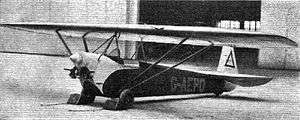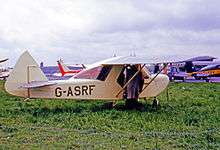Luton Minor
| Luton Minor | |
|---|---|
 | |
| Luton Minor (G-AEPD) at Heston Aerodrome, 1937 | |
| Role | Ultralight |
| Manufacturer | Light Aircraft Association |
| Designer | C.H. Latimer-Needham |
| First flight | 3 March 1937 |
| Produced | 30 |
| Unit cost |
£85 (plans only, 2011) |
The Luton L.A.4 Minor was a 1930s British single-seat high-wing ultra-light aircraft. The prototype was built by the Luton Aircraft Limited, and design plans were later adapted and copies sold for homebuilding.
History
The L.A.3 Minor ultralight was powered by a 35 hp Anzani inverted-vee air-cooled engine, and was of spruce, ply and fabric construction. It was designed by C.H. Latimer-Needham, and built by Luton Aircraft at Barton-in-the-Clay, Bedfordshire in 1936, using the fuselage and components of the earlier experimental L.A.2 tandem-wing aircraft. The prototype L.A.3 Minor, registered G-AEPD, first flew on 3 March 1937 at Heston Aerodrome.[1] The aircraft was a successful flyer despite the low-powered engine, and it was then redesigned for home construction. Designated the L.A.4 Minor, it had a strutted undercarriage and parallel wing struts. The first L.A.4 Minor was built at the company's new factory (the Phoenix Works) at Gerrards Cross in Buckinghamshire. It was fitted with a 40 hp ABC Scorpion two-cylinder horizontally-opposed engine. All subsequent Luton Minors were home-built from plans sold by the company.
The Phoenix Works had burnt down during 1943, and Luton Aircraft had closed, so designer C.H. Latimer-Needham and A.W.J.G. Ord-Hume created a new company in March 1958 to take over the design rights for the Luton Minor. Latimer-Needham updated the design to take more modern lightweight four-cylinder engines and an increased all-up weight. The redesigned aircraft was designated L.A.4A Minor. The design, and subsequently the aircraft, has been built all over the world as a homebuilt aircraft with a wide variety of engines, with the plans for the aircraft being distributed by Alf Knowles as the Knowles Duet before being passed on to the Popular Flying Association (now the Light Aircraft Association) in the UK.[2][3]
Variants
- L.A.3 Minor
- Prototype ultralight, one built.
- L.A.4 Minor
- Homebuilt version, one factory built and numerous homebuilt examples.
- L.A.4A Minor
- Updated homebuilt version to take more modern engines, all homebuilt.
- Knowles Duet
- Plans for the L.A.4A Minor were distributed as the Knowles Duet.
- Coates Swalesong S.A.I
- A Luton Minor built by James Coates, registered as G-AMAW.

- Gowland Jenny Wren
- A Luton Minor with enclosed cockpit and tricycle landing gear; registered G-ASRF it first flew on 13 OCtober 1966 at Panshanger.
Specifications (L.A.4A)
Data from British Civil Aircraft since 1919 Volume 3[4]
General characteristics
- Crew: 1
- Length: 20 ft 0 in (6.10 m)
- Wingspan: 25 ft 0 in (7.62 m)
- Height: 6 ft 3 in (1.91 m)
- Wing area: 125 ft² (11.6 m²)
- Airfoil: RAF 48 [2]
- Empty weight: 450 lb (205 kg)
- Max. takeoff weight: 750 lb (341 kg)
- Powerplant: 1 × Lycoming O-145-A2 four-cylinder horizontal opposed, 55hp (41 kW)
Performance
- Maximum speed: 74 knots (85 mph, 137 km/h)
- Range: 156 nm (180 miles, 290 km)
- Rate of climb: 450 ft/min (2.3 m/s)
Notes
References
- Jackson, A.J. (1974). British Civil Aircraft since 1919 Volume 3. London: Putnam. ISBN 0-370-10014-X.
- Smith, R. 2002. British Built Aircraft Vol.1 Greater London. Tempus. ISBN 0-7524-2770-9
- Taylor, JWR (Editor) (1988). Jane's All the World's Aircraft, 1988–1989. Jane's Information Group. ISBN 0-7106-0867-5.
External links
| Wikimedia Commons has media related to Luton Minor. |